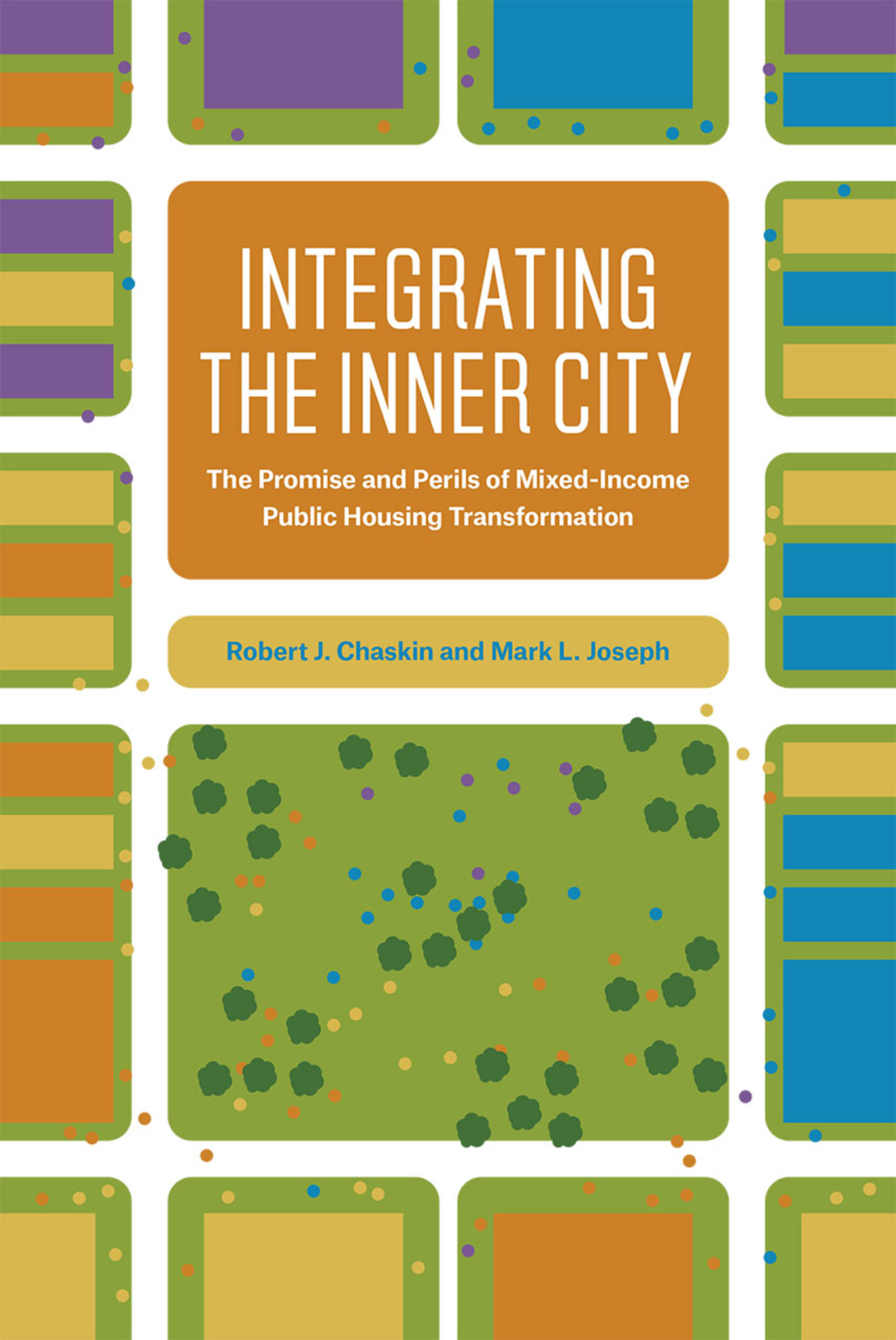Deep into six years of fieldwork, academic articles, and policy briefs, professors Robert J. Chaskin and Mark L. Joseph decided that the complex story of Chicago’s mixed-income redevelopments needed to be told in its entirety.
Responding to that need, they published Integrating the Inner City: The Promise and Perils of Mixed-Income Public Housing Transformation in 2015. Clearly written and meticulously researched, the book gives readers a rare inside look at Chicago’s mixed-income developments and, in doing so, powerfully argues that mixed-income redevelopment is not the integrationist solution for curing urban poverty that it is often said to be. Chaskin and Joseph divide the book into two parts, the first providing theory and historical context and the second contributing the empirical heart of the book.
Part one of the book tells the history of national housing reform efforts, culminating in mixed-income housing reform. Beginning with the 1937 Housing Act, which authorized and funded the construction of highly subsidized public housing developments across the nation that became oases of quality low-rise housing, the story then moves on to the decline of public housing in the fifties and sixties. Urban renewal put poorly designed high-rise public housing primarily in African-American neighborhoods that already lacked resources and jobs. Policymakers responded in two ways: by relocating public housing residents to more diverse neighborhoods with lower poverty rates through Section 8 housing vouchers and by establishing place-based mixed-income redevelopments under the Department of Housing and Urban Development’s 1992 plan, HOPEVI. From the latter effort arose Chicago’s Plan for Transformation, the most ambitious plan to fix public housing, which included a particularly zealous mixed-income redevelopment component.
Part two of the book analyzes the policy shift towards mixed-income redevelopment in Chicago. Chaskin and Robert focus on Park Boulevard, Oakwood Shore, and Westhaven Park, replacing Stateway Gardens, Ida B. Wells, and the Henry Horner Homes, respectively. Both Park Boulevard and Westhaven Park were designed by for-profit developers; the third, Oakwood Shore, was developed by a nonprofit developer and a local minority-owned developer.
According to Chaskin and Joseph, each site attempted to build community among tenants of varying incomes, but to little avail. They hosted youth sports teams, barbecues, movie nights, and youth summer programming, but activities were sporadic and short-lived. Often, higher income residents wouldn’t show up. They established job training and placement, adult education, health and wellness programs, and financial education, but they did not have enough money to provide long-term services. Chaskin and Joseph include interviews from public housing residents and higher income residents that vividly depict both the distance between residents and the dissatisfaction of public housing residents.
Coupled with these relatively unsuccessful attempts at supporting residents of public housing, each site has “dictionary-sized rules and regulations” demanding almost complete compliance from these residents. The rules are enforced by development team members, hundreds of on-site cameras, and an increased police presence with a zero-tolerance policy for acts as harmless as “hanging out” outdoors. In addition, there are ongoing and uneven inspections: low income tenants must open their door each month for inspections, which can incur a range of penalties, compared to homeowners or higher income renters within the developments who do so once a year, if that. If low income tenants accrue three penalties, they are forced out of the development.
Chaskin and Joseph assert that the aggregate effect of all of these measures is incorporated exclusion rather than integration: differential targeting and inequitable enforcement of rules create new dynamics of marginalization rather than helping public housing residents feel like valued parts of the mixed-income community.
That failure has implications. As Chaskin articulated in an interview, “I think there’s a tendency for policy to run ahead of evidence. Mixed income redevelopment has been sort of broadly embraced on the policy level and I don’t think that this book suggests that that is fundamentally always a bad idea, but I think that the enthusiasm for it ought to be tempered by the experience we’re having. I think that a particular lesson here is the tendency to put too much emphasis or too much faith in addressing very complex socioeconomic problems like urban poverty with a relatively narrow policy intervention, which is mixed-income housing.”
Beyond condemning and explaining the failures of mixed-income housing, Chaskin and Joseph conclude with a comprehensive set of recommendations. They suggest greater communication among actors about social goals in a particular site (asking the question, how should key actors promote greater mobility and social inclusion?); adopting and continuing Opportunity Chicago, a Chicago Jobs Council project aimed at finding work for public housing residents living in mixed income developments; training public housing residents to do some of the jobs necessary to build the developments; making a long term investment in social mobility programming for public housing residents; offering more services and primary supports for public housing residents; and allocating and integrating public spaces within neighborhoods.
More than an indictment and incredibly detailed, Integrating the Inner City: The Promise and Perils of Mixed-Income Public Housing Transformation is fascinating and timely, a must-read for those concerned with public policy and affordable housing. ¬


I think this book is an excellent starting point of examining the millions of dollars spent by various partners, e.g., US government, state and local governments, and private enterprise, and how we can provide safe, affordable, healthy housing for those would otherwise be unable to do so on their own. It also gives those more affluent residents an opportunity to interact with those with whom they would otherwise not in the course of their daily lives.